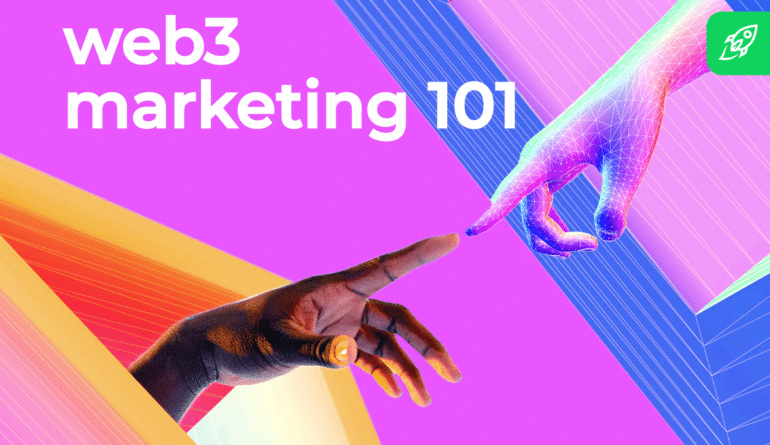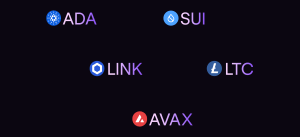Web Marketing 101: What Business Owners and Digital Marketers Need to Know
Web3 marketing is more than a buzzword—it’s a game changer for digital marketers and business owners. As the internet moves toward decentralization, brands that adapt early will win. This shift isn’t just about keeping up—it’s about standing out, building engaged communities, and earning trust through transparency.
In this guide, we’ll cut through the noise and break down what Web3 marketing really means. You’ll see how brands are using it, what strategies work, and how to apply them to your business—without the fluff.
What is Web 3.0?
Web3 is the next version of the internet, built on decentralization, user ownership, and open access.
Right now, Web2 platforms control data, content, and monetization. In Web3, that control shifts to users through blockchain technology. That means more transparency, fewer gatekeepers, and new ways for brands to connect with people.
Also read: What is web3?

How Web3 Marketing Differs from Traditional and Web2 Marketing
Web3 marketing flips the script. No more data hoarding, no more middlemen cashing in. It’s about decentralization, ownership, and data usage that actually benefits users. Real engagement replaces ad spam, and brands don’t just sell—they build communities. And since everything’s on-chain, there’s no room for shady tactics.
Decentralization and Data Ownership
Big platforms love to collect your data, control it, and sell it behind the scenes. That’s Web2. Web3 does the opposite. It hands ownership back to users with blockchain technology, removing middlemen and making sure every transaction is transparent. Advertisers only pay for real results, fraud takes a backseat, and data stays where it should—under user control.
Community-Driven Engagement
Web3 marketing isn’t a one-way street. Instead of treating customers like numbers, brands bring them into the ecosystem. Loyalty isn’t forced—it’s rewarded through tokens, digital collectibles, and perks that make engagement worthwhile. When people feel a real sense of ownership, they stick around—not just as buyers, but as brand champions.
Transparent and Immutable Campaign Tracking
Ever paid for ads and wondered if half those clicks were from real people?
Web3 solves that.
Ad fraud is everywhere—bots inflating impressions, click farms juicing stats, and platforms “adjusting” the numbers behind closed doors. With blockchain, that nonsense ends. Every view, click, and conversion is recorded on-chain, permanently and transparently. No hidden manipulations, no inflated metrics—just verifiable engagement that advertisers can actually trust.
Plus, blockchain means real-time tracking with zero middlemen. You don’t have to rely on third-party platforms to tell you if your campaign worked. The data is public, immutable, and fraud-proof. Advertisers pay for genuine interactions, and users keep control of their data.
Why Web3 Matters for Businesses?
Web3 is helping to change industries by introducing decentralized technologies and reshaping traditional models across the digital landscape. From finance to healthcare, industries are evolving fast.
Finance
Finance is leading the Web3 revolution.
For centuries, banks and financial institutions have been the ultimate gatekeepers—deciding who gets a loan, how long transactions take, and how much of a cut they take. But DeFi (decentralized finance) changes the game.
DeFi platforms let people borrow, lend, and trade assets without middlemen slowing things down or charging ridiculous fees. Smart contracts enforce the rules, ensuring that everything runs smoothly and transparently. There’s no banker deciding whether you qualify—just code that executes instantly when conditions are met.
Then there’s tokenized securities—real-world assets represented as digital tokens. Imagine investing in fractional shares of real estate, art, or stocks, all without dealing with outdated systems and high fees. Web3 isn’t just making finance better—it’s making it fairer, faster, and more accessible.
Art and Entertainment
For decades, artists had to go through galleries, record labels, and publishers to reach an audience and get paid. And in return? They got a tiny cut of their own work.
Web3 changes that. NFTs (Non-Fungible Tokens) let creators sell directly to their fans, with built-in proof of ownership and royalties. Every time an NFT changes hands, the artist still gets paid—no sneaky middlemen taking the lion’s share.
For musicians, filmmakers, and writers, it’s the same deal. Decentralized streaming, tokenized memberships, and blockchain-powered ticketing mean artists own their revenue streams and control their work. No more corporate middlemen—just creators, their fans, and an ecosystem that rewards real engagement.
Supply Chain Management
Right now, supply chains are a mess of disconnected systems, third-party brokers, and unverifiable claims. Fraud happens at every level—fake goods, missing shipments, and suppliers cutting corners.
Web3 technologies improve supply chain transparency with immutable blockchain records of product origins and movements. This fosters authenticity and traceability, benefiting industries such as manufacturing and logistics.
Healthcare
In healthcare, Web3 facilitates secure, decentralized management of patient data. Decentralized medical records let individuals store and share their health data securely—without jumping through bureaucratic hoops.
Blockchain-powered data sharing improves coordination between providers, reduces errors, and eliminates data silos. Privacy is also baked in—your data stays yours, with full control over who can see it.
Education
Web3 doesn’t just change how education is delivered—it changes who controls it.
Academic credentials shouldn’t be easy to forge, hard to verify, or buried in bureaucratic systems. Right now, verifying education requires endless emails, paperwork, and expensive services.
Web3 fixes that. Blockchain-based credentials let students store their diplomas, certifications, and transcripts permanently and verifiably on-chain. Employers can instantly check qualifications without needing to call universities or pay verification fees.
Decentralized learning platforms also make education more accessible. Think global, on-demand courses with verified certifications that can’t be faked. Students own their academic records, can share them instantly, and never worry about institutions losing or blocking their credentials.
So, Web3 is changing the game for businesses. Whether it’s finance, healthcare, or supply chains, decentralization is making industries more efficient and user-focused. Companies that embrace it now will lead the next digital revolution.
Key Technologies Driving Web3 Marketing
Web3 is rewriting the rules. Your data? Yours. Your engagement? Rewarded. Your experience? Decentralized.
How? Blockchain makes marketing transparent. Smart contracts automate deals. dApps connect users directly. NFTs turn loyalty into real value. DAOs let communities lead. Welcome to marketing without the middlemen.
Blockchain and Its Role in Marketing
Think of blockchain as a public, tamper-proof receipt for everything. Unlike traditional marketing, where data gets hoarded by platforms and manipulated behind closed doors, blockchain keeps every transaction, interaction, and engagement on record—permanently.
Smart Contracts and Automation
Traditional marketing is full of middlemen, delays, and inefficiencies. Smart contracts fix that.
These self-executing contracts handle payments, ad placements, and campaign tracking without the need for third-party oversight. The rules are coded in—if a campaign meets its engagement goals, the budget is distributed instantly and fairly. No approvals, no delays, no unnecessary fees.
For brands, this means lower costs, streamlined campaigns, and zero room for manipulation. For users, it ensures fair, transparent rewards for engagement.
Web3 marketing doesn’t need trust—it’s built on automated, verifiable execution.
Decentralised Applications (dApps)
In Web2, platforms control access to users, dictate engagement rules, and own the data. In Web3, users own their interactions. dApps power tokenized loyalty programs, gamified experiences, and exclusive brand communities, all without relying on ad-driven, data-harvesting platforms.
Decentralized applications (dApps) enable direct, peer-to-peer interactions without central intermediaries. They power innovative marketing tactics like tokenized loyalty programs and gamified experiences, enhancing engagement and user retention.
NFTs and Token-Gated Experiences
Web3 marketing rewards exclusivity. Instead of generic discounts or cookie-cutter loyalty points, brands use NFTs to create rare, high-value experiences that people actually care about.
NFTs create unique, limited-edition campaigns, boosting engagement through exclusivity. They grant access to premium content or events, driving brand loyalty. Token-based experiences incentivize participation and enable direct, permission-based marketing.
DAOs and Community-Led Branding
The future of branding is community-driven. DAOs (Decentralized Autonomous Organizations) give customers a seat at the table, letting them vote on brand decisions, influence product direction, and co-create experiences.
When customers feel like they’re part of a brand, not just a target audience, they go from consumers to advocates.
Core Principles of Web3 Marketing
Web3 marketing is defined by decentralization, transparency, tokenized incentives, and community engagement. These principles transform customer relationships and build trust.

Decentralisation and Ownership
In traditional marketing, users are the product. Their data is collected, sold, and used to fuel advertising algorithms—often without their knowledge or consent. Brands act as gatekeepers, deciding who gets access and how interactions happen.
Web3 empowers users with control over their data and direct brand interactions, reducing third-party interference. Permission-based strategies encourage data sharing in exchange for value, fostering trust and authentic engagement.
Transparency and Trust
Let’s be honest: traditional marketing isn’t exactly known for its transparency. Metrics are manipulated, engagement numbers are inflated, and brands often make claims they can’t back up.
Blockchain, on the other hand, ensures transparency in transactions and marketing campaigns, building trust with consumers. Immutable records verify authenticity, while transparent reward distribution boosts participation and engagement.
Tokenisation and Incentives
Loyalty programs in Web2? Mostly useless. Points pile up with no real value, rewards are limited, and brands control the entire system. Users have no ownership, no say, and no flexibility.
Web3 aims to change the entire loyalty model with tokenized incentives.
Tokens power Web3 loyalty programs, rewarding customer actions and driving engagement. Social tokens and DAOs enable personalized experiences and empower users to participate in brand decisions, enhancing loyalty.
Community Engagement
In Web2, community engagement is often shallow and performative. With so-called social media marketing, brands post on social media, collect likes, and call it a day. As a result, most of those interactions are meaningless.
Web3’s innovative marketing strategies thrive on strong, engaged communities. Platforms like Discord and Telegram facilitate direct communication, giving users a voice in brand direction. This participatory model fosters loyalty, drives growth, and creates sustainable marketing ecosystems.
Challenges and Risks in Web3 Marketing
Web3 marketing isn’t a quick win—it’s an entirely new frontier, and with that comes serious risks. For all the talk about decentralization, ownership, and transparency, the reality is that adoption is slow, regulations are unpredictable, security threats are everywhere, and measuring success is harder than ever.
For brands entering this space, the margin for error is razor-thin. A single misstep—whether it’s a regulatory violation, a security breach, or a failed community rollout—can tank credibility and drain resources fast. Web3 users don’t forgive easily, and trust is hard-earned.
If marketers want to survive this transition, they need to move carefully, plan strategically, and stay ahead of these challenges.
Regulatory Uncertainty and Compliance
Regulation is the elephant in the room for Web3 marketing. Governments and financial authorities are scrambling to catch up with blockchain innovations, and that uncertainty is a ticking time bomb.
One day, a project is fully operational—the next, it’s shut down for violating financial regulations. Laws vary wildly across regions, and they change fast. What’s legal today might be banned tomorrow. Marketers must stay informed about legal developments to avoid potential violations.
For instance, the classification of certain digital assets as securities can impose stringent compliance requirements. The lack of clear regulatory frameworks can lead to legal ambiguities, making it essential for Web3 marketers to engage legal experts to ensure adherence to applicable laws and to develop strategies that mitigate regulatory risks.
Also read: MiCA: Impact on Web3 Businesses
User Adoption and Technical Barriers
The promise of decentralization is exciting—but for the average user, it’s a nightmare to navigate.
User adoption of Web3 technologies is hindered by technical complexities and a steep learning curve. Many users find decentralized platforms less intuitive compared to traditional web services, which can deter engagement.
Challenges such as setting up digital wallets, understanding blockchain mechanics, and managing private keys require a level of technical proficiency that is not yet widespread. To overcome these barriers, Web3 marketers need to focus on user education and the development of more user-friendly interfaces.
Simplifying the onboarding process and providing clear guidance can enhance user experience and promote broader adoption of Web3 platforms.
Security and Fraud Risks
Security concerns are paramount in Web3 marketing due to the irreversible nature of blockchain transactions and the prevalence of fraudulent activities. Phishing attacks, smart contract vulnerabilities, and scams pose significant risks to both users and marketers. The decentralized and pseudonymous aspects of Web3 can make it challenging to trace malicious actors.
For brands, security isn’t just about protecting users—it’s about protecting their own reputation. A single breach can:
- Destroy customer trust in an instant.
- Lead to regulatory scrutiny.
- Result in lawsuits and financial losses.
Implementing robust security measures, conducting regular audits, and educating users about potential threats are crucial steps in mitigating these risks. Building trust through transparency and demonstrating a commitment to security can enhance brand reputation in the Web3 space.
Measuring ROI in a Decentralised Ecosystem
Traditional marketing has clear success metrics: click-through rates, conversion rates, customer lifetime value.
Web3? Not so much.
Assessing the return on investment (ROI) in Web3 marketing is complex due to the decentralized and often anonymous nature of blockchain transactions. Traditional metrics and tracking tools may not apply, making it difficult to attribute marketing efforts directly to user actions.
The lack of centralized data collection points challenges the effectiveness of conventional analytics. Marketers must develop new methodologies to measure engagement and success, potentially leveraging on-chain data analysis and community feedback. Innovative approaches to tracking and analytics are necessary to accurately assess the impact of marketing strategies in the Web3 environment.
Web3 Marketing Strategies
Web3 marketing strategies leverage decentralized web technologies to engage target audiences beyond traditional digital marketing methods. Key approaches include community building, token-gated commerce, metaverse integration, bounty campaigns, and decentralized ad networks.
Community Building
Community is central to Web3 marketing. Platforms like Discord and Telegram create spaces where brands interact directly with their audience. Engaging discussions, contests, and user-generated content foster loyalty and organic growth. U
And, unlike traditional marketing, Web3 communities thrive on shared ownership and active participation.
Token-Gated Commerce
Token-gated commerce offers exclusive experiences using branded tokens or NFTs, promoting loyalty and deeper brand alignment. This strategy integrates blockchain into content marketing, enabling real-time tracking of engagement. Tokenized rewards and perks incentivize customer participation, replacing traditional digital marketing techniques with personalized, decentralized experiences.
Metaverse Integration
The metaverse provides immersive spaces for brands to engage audiences in new ways. Virtual events, product showcases, and branded experiences enhance interaction and build stronger communities. This strategy goes beyond traditional marketing by creating interactive, decentralized brand ecosystems.
Decentralized AD Networks
Decentralized advertising leverages blockchain technology to eliminate intermediaries, granting users greater control over their data. Unlike traditional advertising, which relies on centralized platforms to collect and monetize user information, decentralized ads promote transparency and trust. Each impression and click is securely recorded on the blockchain, reducing ad fraud and ensuring advertisers pay for genuine engagement. This approach boosts efficiency and upholds Web3 principles, prioritizing user privacy and data ownership.
Web3 marketing transcends traditional digital marketing tactics like search engine optimization. It offers opportunities to enhance user experience through rich, interactive, and highly targeted ads within a decentralized ecosystem.
Get the must-have checklist now!

Some Noticeable Web3 Marketing Campaigns Examples
Contrary to popular belief, Web3 isn’t just for crypto startups. Big brands are already using NFTs, blockchain, and virtual spaces to engage customers in new ways. Here’s how some of the biggest names are making it work.
Coca-Cola
Coca-Cola entered the NFT space with the “Coca-Cola Friendship Box.” This collection featured exclusive digital wearables, including a virtual Coca-Cola bubble jacket. The campaign launched on International Friendship Day, giving fans a taste of Web3 while boosting brand loyalty.
Nike
Nike didn’t just dip a toe into Web3—it bought an entire digital fashion company. With its acquisition of RTFKT, Nike now sells virtual sneakers and apparel for use in online worlds. The result? A new wave of sneakerheads collecting digital kicks alongside physical ones.
Gucci
Gucci isn’t waiting for the future—it’s building it. The brand launched the “Gucci Garden” on Roblox, letting users explore, buy, and wear limited-edition virtual items. This move pulls in younger, digital-first audiences while keeping Gucci ahead of the curve.
Starbucks
Starbucks introduced “Starbucks Odyssey,” turning customer loyalty into a blockchain-powered experience. Customers earn digital collectible stamps (NFTs) that unlock perks and exclusive coffee experiences. It’s not just rewards—it’s a new way to keep customers hooked.
Louis Vuitton
For its 200th anniversary, Louis Vuitton dropped “Louis the Game.” Players guided Vivienne, a virtual character, through a digital world, collecting NFT candles that told the brand’s history. Luxury, storytelling, and Web3 all in one smart campaign.
NBA
The NBA turned game highlights into digital trading cards. Its “NBA Top Shot” platform lets fans buy, sell, and trade officially licensed NFT moments. This decision brought the company millions in sales and mainstream NFT adoption.
These brands aren’t waiting for Web3 to go mainstream—they’re making it mainstream. Whether it’s NFTs, virtual goods, or blockchain rewards, they’re proving that Web3 marketing isn’t the future—it’s happening now.
How Changelly and Tangem Successfully Launched a Web3 Marketing Campaign
Launching a Web3 campaign is like setting up a perfect party. You need the right crowd, the right incentives, and a plan to keep people engaged even after the main event. That’s exactly what Changelly and Tangem did with their “Swap with Love” campaign for Valentine’s Day 2024.
Changelly partnered with Tangem, a self-custodial cold wallet manufacturer, to launch the “Swap with Love” Web3 marketing campaign for Valentine’s Day 2024. Focused on community engagement, education, and long-term value, the campaign highlighted Web3 values of decentralization, security, and user ownership.

How It All Came Together
The campaign spanned 21 days, divided into key phases:
- Day 1 – Community Engagement: Teased the campaign on social media and email newsletters, offering a promo code, SWAPWITHLOVE, for Tangem wallets.
- Days 2–13 – Education & Awareness: Published a Tangem wallet review on Changelly’s blog (1.5M monthly readers), hosted a quiz with giveaways, and cross-promoted on both platforms with influencer support.
- Day 14 – Zero-Fee Push: Launched a one-week zero-fee swap campaign via email blasts, Tier 1 media, and banner ads.
- Days 15–21 – Long-Term Engagement: Held an AMA on X Spaces and interactive activities on Telegram to maintain momentum.
Results and Impact
The results spoke for themselves: the campaign reached 1.18 million people and recorded 6,590 zero-fee swaps. Banner-to-swap conversions doubled from prior campaigns, while influencer posts generated 350K impressions, and official channels reached 75K. Partner placements added 750K more impressions. Both Changelly and Tangem praised the campaign for its success and strong community response, emphasizing how Web3-centered strategies drive meaningful engagement.
Is Your Web3 Marketing on Point?
Web3 moves fast, and keeping up can feel overwhelming. That’s why Changelly created a checklist to help you stay ahead. Whether you’re launching a campaign or refining your strategy, this guide walks you through everything you need to know for 2025.
It covers community building, on-chain analytics, and more, helping both startups and established projects structure their marketing. You’ll spot gaps, find new opportunities, and align your strategy with what Web3 users actually want.
With this guide, you’ll step into Web3 marketing with confidence. Use Changelly’s expertise to build a stronger, smarter Web3 presence.
Where is Web3 Marketing Heading?
Web3 digital marketing services are becoming more user-centric, transparent, and data-driven. The main goal—giving users control.
- Personalization powered by blockchain lets users own their data, building trust.
- NFTs go beyond collectibles, offering exclusive access and deeper brand loyalty.
- Decentralized social media platforms help brands engage communities without privacy concerns.
- Blockchain-based advertising cuts fraud and verifies every ad impression.
Together, these trends reshape how brands connect with users—on their terms.
Final Thoughts
It looks like Web3 marketing isn’t hype—it’s the next evolution of digital engagement. Brands that embrace decentralization, community-driven strategies, and blockchain-powered innovation will build stronger, longer-lasting relationships.
FAQ
Do I need to understand blockchain technology to implement Web3 marketing?
Not completely—but a deep understanding helps. Web3 marketing relies on decentralized platforms, NFTs, and cryptocurrencies, all built on blockchain. You don’t need to be an expert, but knowing how smart contracts work makes it easier to create transparent, trust-driven campaigns.
Since privacy and ownership are core Web3 values, marketers with a deep understanding of blockchain principles can craft stronger, more authentic messages and build a better digital marketing strategy.
How can small businesses or startups leverage Web3 marketing without a big budget?
Web3 marketing doesn’t require a huge budget. Small brands can:
- Accept crypto payments to attract a Web3-savvy audience.
- Build a community on decentralized platforms for direct engagement.
- Partner with micro-influencers in Web3 to gain credibility.
- Create NFTs or other unique digital assets as rewards for loyal customers.
Authenticity, transparency, and community matter more than ad spend in Web3.
How does Web3 marketing affect data privacy and customer relationships?
Just like we discussed earlier, Web3 shifts data ownership to users, breaking away from Web2’s model of unchecked data collection. Instead of brands extracting information, customers decide what to share and when, making privacy a built-in feature, not an afterthought.
This change redefines customer relationships. When users have control, trust builds naturally, engagement becomes more meaningful, and loyalty follows. Brands that fully embrace transparency and user consent won’t just adapt to Web3—they’ll lead the way.
Is Web3 marketing just a trend, or will it become mainstream?
Web3 marketing isn’t just hype—it’s the natural evolution of digital engagement. As the world wide web moves toward decentralization, user ownership, privacy, and transparency are becoming more than ideals—they’re expected.
As we’ve seen, major industries are already experimenting with Web3 to create more user-centric experiences. The question isn’t if Web3 will take over, but when. Adoption is growing, and consumer demand for control over their data keeps pushing it forward.
That said, challenges remain. Regulations are still uncertain, user adoption takes time, and security risks can’t be ignored. But businesses that embrace Web3 early will have a huge advantage when the shift becomes inevitable. Those that wait? They risk falling behind.
Disclaimer: Please note that the contents of this article are not financial or investing advice. The information provided in this article is the author’s opinion only and should not be considered as offering trading or investing recommendations. We do not make any warranties about the completeness, reliability and accuracy of this information. The cryptocurrency market suffers from high volatility and occasional arbitrary movements. Any investor, trader, or regular crypto users should research multiple viewpoints and be familiar with all local regulations before committing to an investment.
The post Web Marketing 101: What Business Owners and Digital Marketers Need to Know appeared first on Cryptocurrency News & Trading Tips – Crypto Blog by Changelly.
Cryptocurrency News & Trading Tips – Crypto Blog by Changelly




















